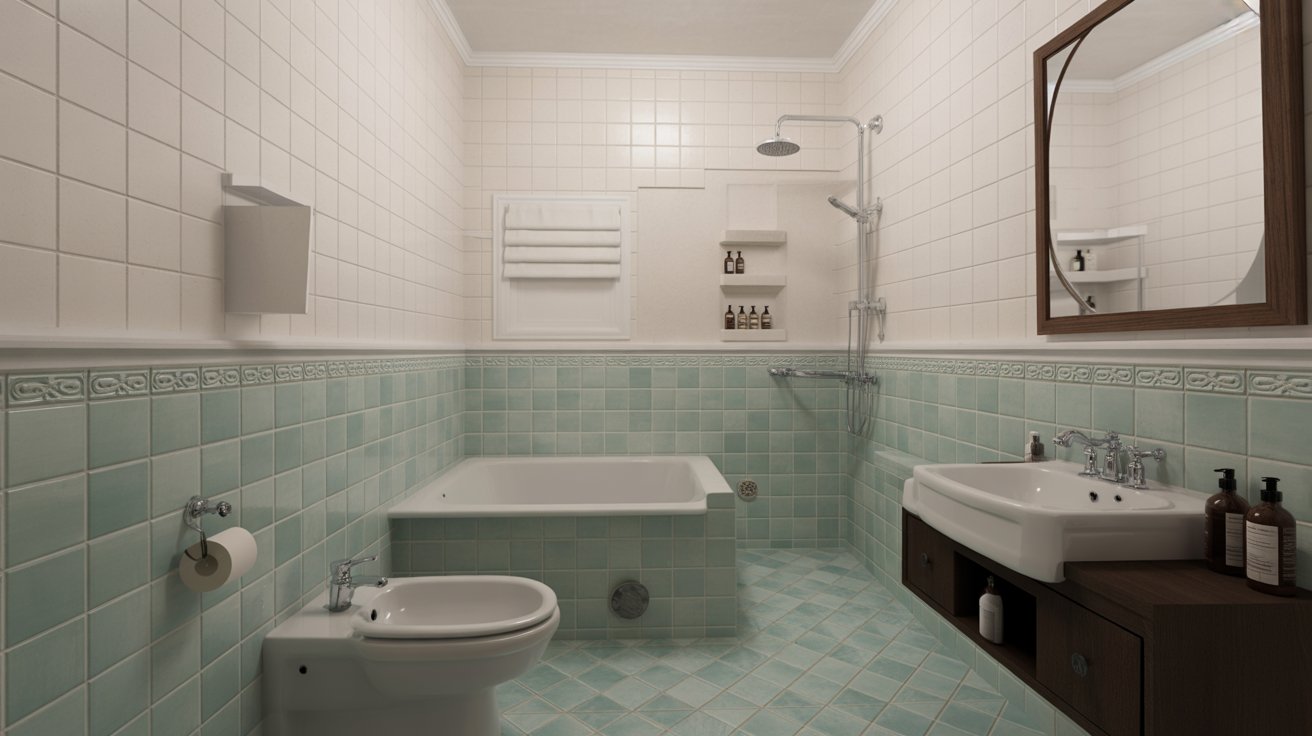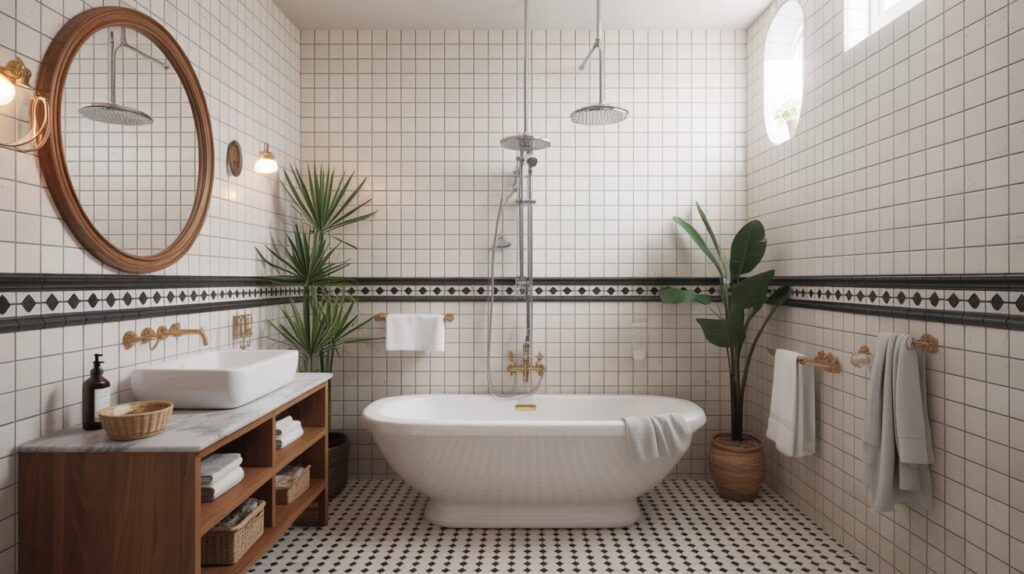Tiling Ideas for Small Bathrooms: Transforming your compact bathroom into a stylish and spacious‑feeling sanctuary
Designing tiling ideas for a small bathroom can feel challenging, yet with the right choices, the result will be both beautiful and functional. This article guides you through smart selections, from tile size and layout to colour and pattern, so you can apply ideas for tiling a small bathroom with confidence.
You will learn how to choose the right materials, create the illusion of space, explore trending motifs and finishes, and incorporate personalised touches that make a real difference.
Why Tile Choice Matters in a Compact Bathroom
When space is limited, every design decision carries weight. Good small bathroom tiling ideas begin with understanding how tile size, colour, finish, height, and layout affect the perception of space. Tiles can visually expand walls, complement lighting, or create flow between zones.
According to one guide: “tiles’ size, their colour, their texture, their shape can all significantly affect the result, modifying the lighting and perspectives and creating an optical effect that makes a space look larger or smaller.”
Choosing the right tile is not just aesthetic but practical. Ceramic and porcelain tile work well in damp environments; they are easy to clean and durable. The layout and grout lines also matter; fewer visible joints mean a more open feel.
Key Considerations Before You Pick Tiles
- Tile size: Many assume small bathrooms need small tiles, but large‑format tiles reduce grout lines and open up the space.
- Colour and finish: Light colours and glossy finishes reflect more light and help make the room feel airy. Darker tones can work, but require careful balance.
- Tile layout: Diagonal installation or vertical striping can trick the eye into perceiving greater depth or height.
- Grout lines: Narrow grout lines and matching grout colour help maintain continuity and avoid visual break‑up of the surface.
- Material and texture: Beyond colour and size, tile material and texture contribute to the feel and performance. For example, textured wall tiles can add character without overwhelming the space.
With these fundamentals in mind, you can explore specific design strategies.
1. Use Light or White Tiles for an Open Feel
A reliable and timeless option in small bathroom tiling ideas is choosing a light or white tile scheme. As one specialist article states: “Whitesurfacese are best known for making space feel more open.”
Why it works
- White or very pale tiles reflect light, brighten dark corners, and make walls recede visually.
- Matching floor and wall tiles in pale tones creates continuity, helping the space feel uninterrupted.
- Simple, clean palettes keep the focus on fixtures and finishes rather than busy surfaces.
How to implement
- Use white subway tiles or large white porcelain floor tiles.
- Keep grout lines in a matching pale tone so they vanish into the surface.
- Add subtle contrast through accessories instead of adding heavy tile patterns.
2. Choose Large‑Format Tiles to Minimise Visual Clutter
In the category of ideas for tiling a small bathroom, one of the more surprising tips is to use larger tiles. According to experts, “Large‑size tiles you can reduce the number of visible joints and thus create a space with a more open, airy ‘feel’.”
Key benefits
- Fewer grout lines means fewer visual interruptions.
- Larger tiles can create a sense of elongation in a narrow layout.
- When used on both floor and walls, they help blur the boundary between surfaces.
Best practices
- Choose tiles at least 600×300 mm or larger for walls, and a similar large size for floors if feasible.
- Ensure the layout fits the room without excessive cuts or odd shapes that would detract from the effect.
- Pair large tiles with minimalistic fixtures to retain a clean aesthetic.
3. Explore Tile Patterns That Draw the Eye and Enhance the Space
When considering tiling ideas small bathroom design, pattern and layout play a big role in the illusion of space.
Popular pattern ideas
- Chevron or diagonal layout: Sets a dynamic angle that lengthens the space visually.
- Vertical or horizontal striping: Vertical stripes add height; horizontal stripes widen the visual field.
- Graphic‑accent tile wall or floor: A controlled use of pattern can become a focal point while not overwhelming the room.
Tips to succeed
- Use pattern sparingly in a small bathroom: one accent wall or a small band of tiles works best.
- Keep the rest of the surfaces in solid, neutral tiles so the pattern has room to breathe.
- Consider texture and sheen: even simple tiles with subtle texture or relief can add interest without crowding the space.
4. Extend the Floor Tile into the Shower for Continuity
One of the more clever ideas for tiling a small bathroom is to extend the same tiles from the main floor into the shower zone. As noted in the competitor article: “Rather than switching the tilework… extend the same shower tiles pattern throughout the entire room. This is responsible for creating a seamless, uniform design scheme that expands the feeling and appearance of spaciousness.”
Advantages
- Visual flow remains uninterrupted from one zone to another.
- The boundary between the wet zone and the dry zone becomes less obvious, helping the space feel unified.
- Installation and cutting might be simpler when using a single tile type across zones.
What to watch for
- Ensure the floor tile in the shower has an adequate anti‑slip texture or finish for safety.
- Consider slope, drainage, and practicality when extending tiles into the shower.
- Use matching or compatible wall tiles so the concept is harmonious.
5. Add Glossy or Reflective Tiles to Amplify Light
To enhance brightness in a small bathroom, reflectivity is a major ally. In the design article, “Using glossy, pale ceramic tiles can help to reflect the artificial light and make the room appear larger.”
How to apply
- Consider glossy wall tiles above matte floor tiles.
- Use mirror‑adjacent tiles to reflect both natural and artificial light.
- Use a subtle sheen instead of high gloss if you want a more understated look.
Caution
- Over‑reflective surfaces may show water spots and streaks more clearly. Choose finishes that strike a good balance between shine and practicality.
- For the floor, ensure the texture is sufficient to keep the surface safe.
6. Use Colour Wisely: Neutrals, Accents and Bold Statements
Colour plays a subtle but important role in small bathroom tiling ideas. While many guides prefer pale neutrals for a space‑enhancing effect, well‑chosen accent colours can add personality without shrinking the room.
Neutral base + accent
- Use a neutral palette (white, cream, light grey) for most tiles.
- Introduce one colour accent, perhaps one wall or a niche, with richer tile or pattern.
- The guide from Westside Tile suggests: “light‑coloured tiles for reflecting light … if you want to do something different from the all‑white design, try light beige tiles for a modern yet minimal appeal.”
Bold statements done right.
- Use a strong colour tile in a limited area (shower wall or backsplash) so that it becomes a focal point without being crowded.
- Keep surrounding surfaces quiet and consistent to allow the accent to stand out.
- Deep tones such as charcoal or black can work for contrast, but maintain good lighting and avoid covering too much surface.

7. Consider Tile Material and Finish for Durability and Style
Beyond aesthetics, tile selection must address durability, maintenance, and moisture resistance. As one source puts it: “High‑quality materials and state‑of‑the‑art finishes … not only to make the space look larger but also to achieve durable, practical solutions.”
Material options
- Porcelain and ceramic: Go‐to choices for bathroom walls and floors due to strength and water resistance.
- Stone or marble‑look tile: Elegant, but ensure proper sealing and consider maintenance.
- Textured or matte finishes on walls: Adds character without compromising surface continuity.
Finish considerations
- Water‑resistant grout and sealed joints will reduce the risk of mould in a small bathroom.
- Large tiles with fewer cuts mean fewer weak points and less maintenance.
- Consider tile thickness and installation method to ensure the floor and underfloor allow drains, transitions, and other practical details.
8. Smart Installation Tips for Small Bathroom Tile Projects
Choosing a great tile is half the story; installation matters just as much when realising small bathroom tiling ideas.
Layout and alignment
- Align major lines (tile edges, grout lines) with architectural lines (doorway, vanity) for cohesion.
- Avoid centring a large rectangular tile awkwardly across a narrow wall; plan from the centre or a key focal point.
- For diagonal or chevron layouts, ensure precision in cutting and alignment for maximum effect.
Grout and joint size
- Use minimal grout width (2 mm or less if the tile allows) to reduce visual interruption.
- Choose grout colour close to tile colour unless you want the joints to stand out deliberately.
Edge and transition management
- Leading edge next to shower, vanity, door must be neatly finished, tile trim, shadow line, or continuous finish.
- If extending floor tile into the shower, plan drainage, slope, and tile bonding carefully to meet waterproofing standards.
Lighting and reflection
- Ensure tile placement complements lighting—wall tiles near light sources will reflect and enhance brightness.
- Avoid placing highly reflective tile opposite powerful light sources if glare is a concern.
Conclusion
Small bathroom tiling ideas do not need to be complicated. With the right tile size, colour, layout, and finish, you can make a compact bathroom feel open, stylish, and custom. Whether you choose large light‑toned tiles, extend floor tile into the shower, or add a smart accent pattern, the goal is cohesion and clarity.
Use minimal contrast in joints, reflect light wisely, and allow your fixtures and layout to shine. The result will be a bathroom that feels significantly larger and more comfortable.
Enhance Your Small Bathroom with Premium Marble and Granite Finishes
In wrapping up and taking the next step, if you are considering tiling for small bathrooms and finishing touches such as marble floors or granite countertops, then you may wish to explore services by us at SF Marble & Granite.
We specialise in marble floor installation, granite countertops installation, and backsplash installation services, ensuring that your small bathroom benefits from premium material and expert workmanship without compromising space or style.
FAQs
What size tile makes a small bathroom look larger?
Large‑format tiles reduce grout lines and create a more seamless surface, which helps the room feel bigger.
Should I use dark tiles in a small bathroom?
You can, but sparingly. Dark tiles may make a space feel cozier but risk shrinking the visual field; best used as an accent rather than full coverage.
Is it better to use the same tile on the floor and walls for a small bathroom?
Using the same tile or a very similar one fosters continuity and makes the space feel more unified and thus larger.
Do glossy tiles help in small bathrooms?
Yes. Glossy, pale tiles reflect light and help open up the room visually, particularly when natural light is limited.
How important is the grout colour in small bathroom tiling?
Very important. A grout colour that blends with the tile keeps the surface reading as one continuous plane, which helps the space feel larger.

